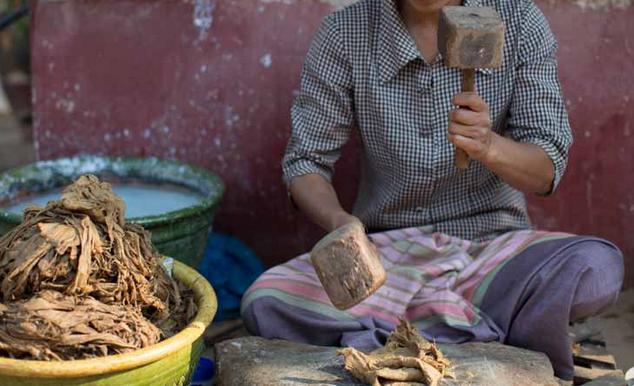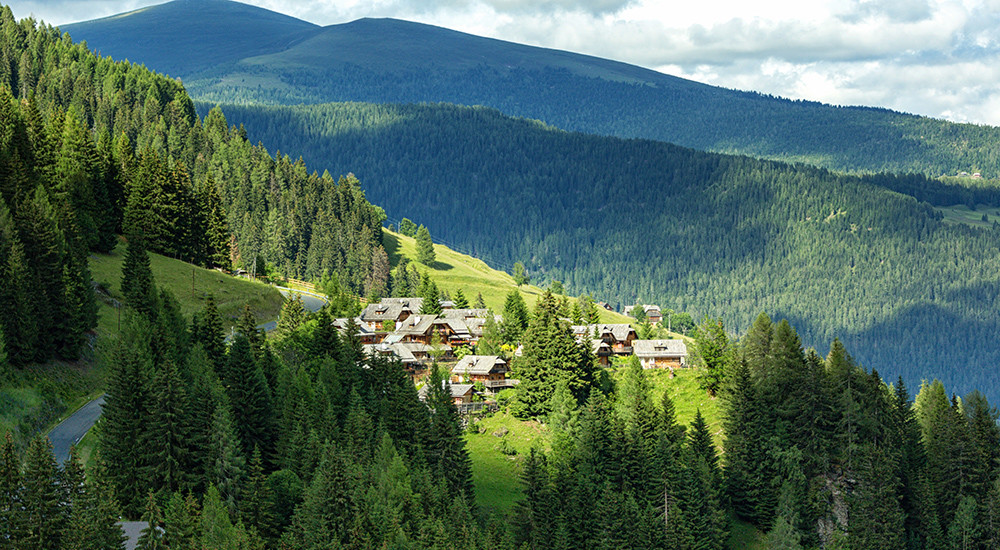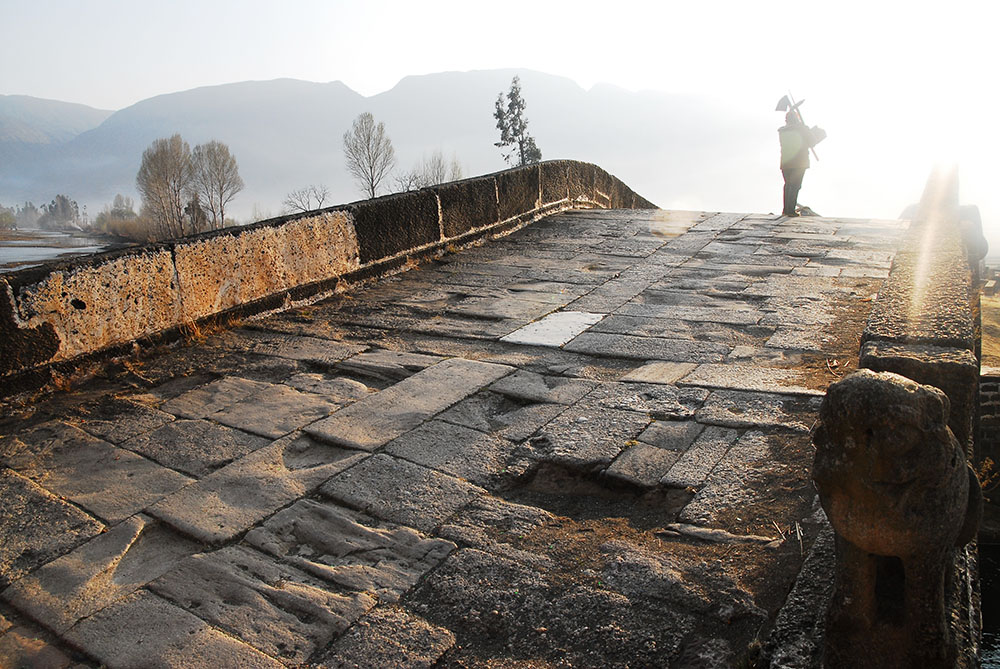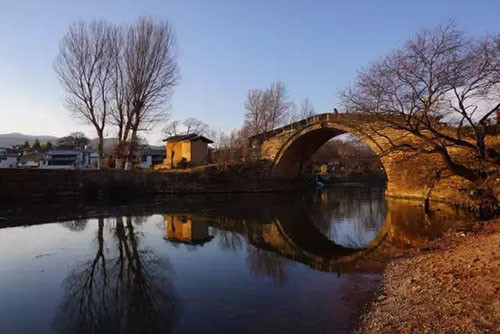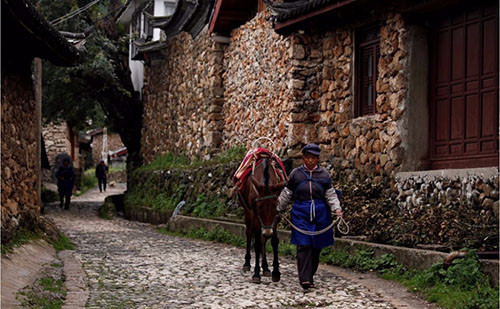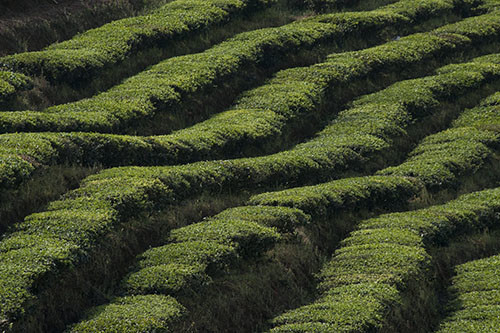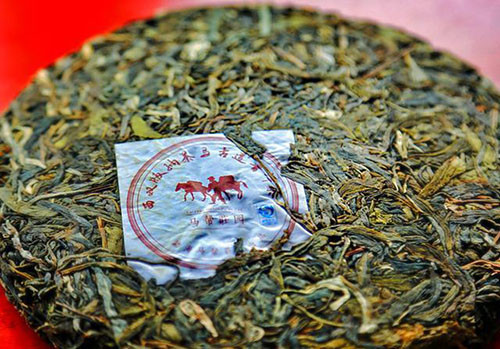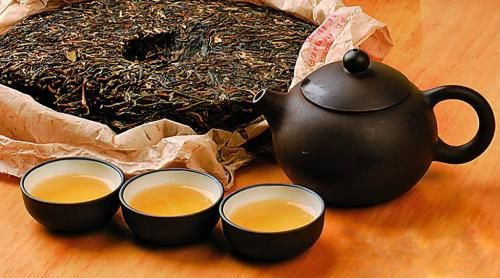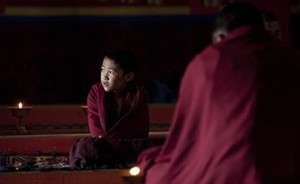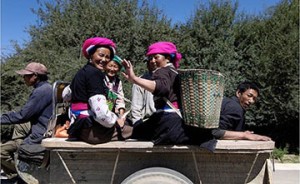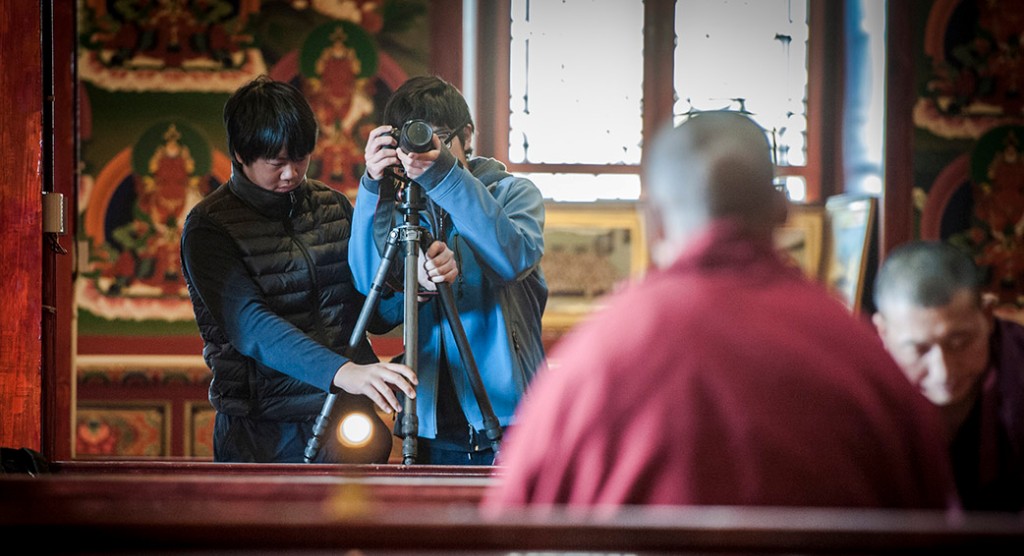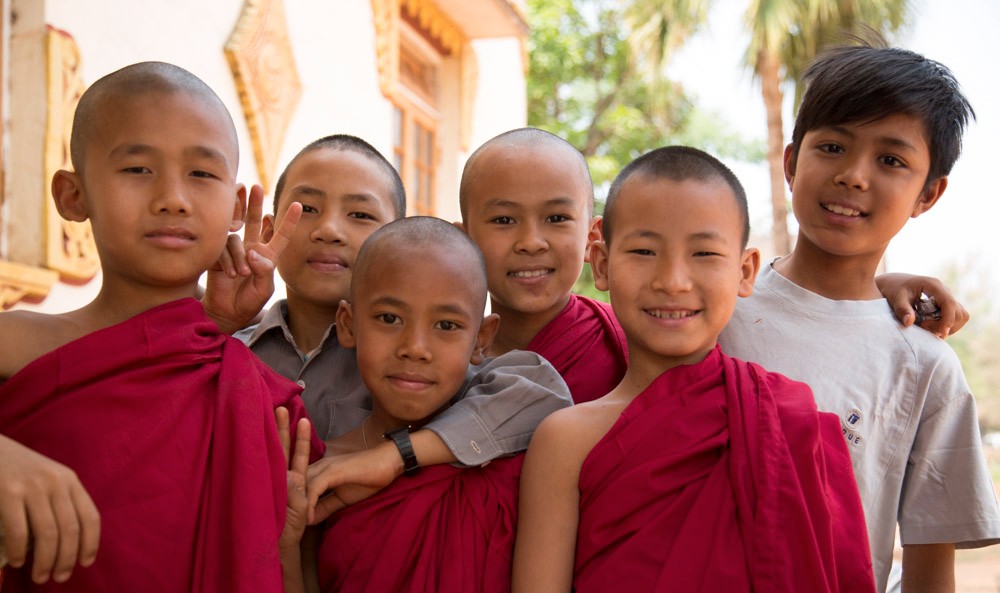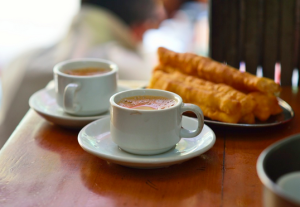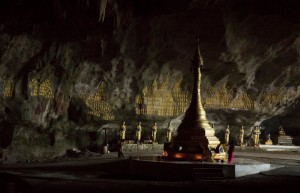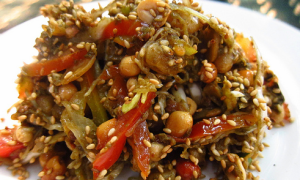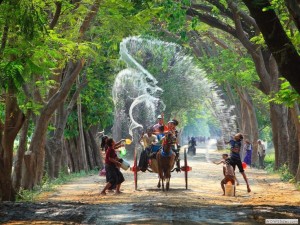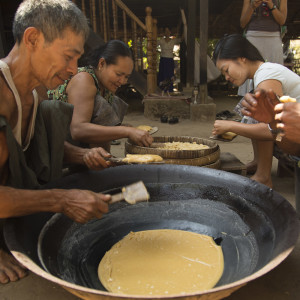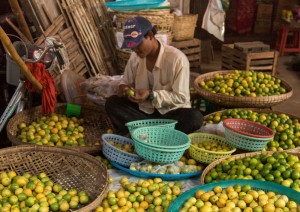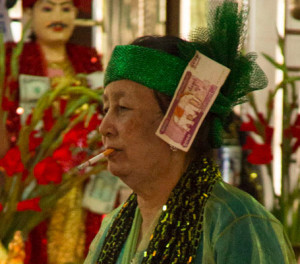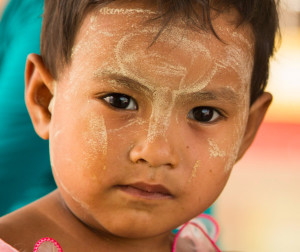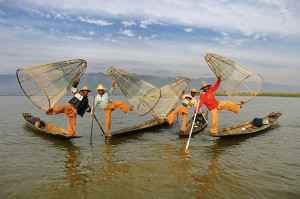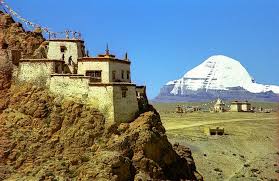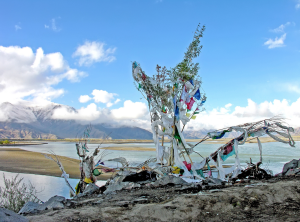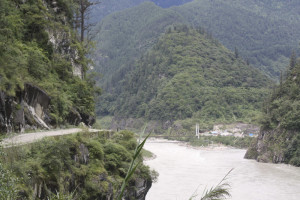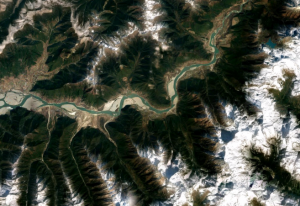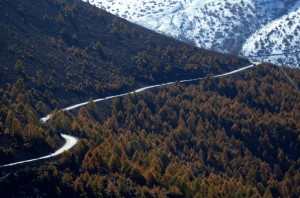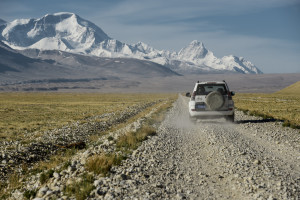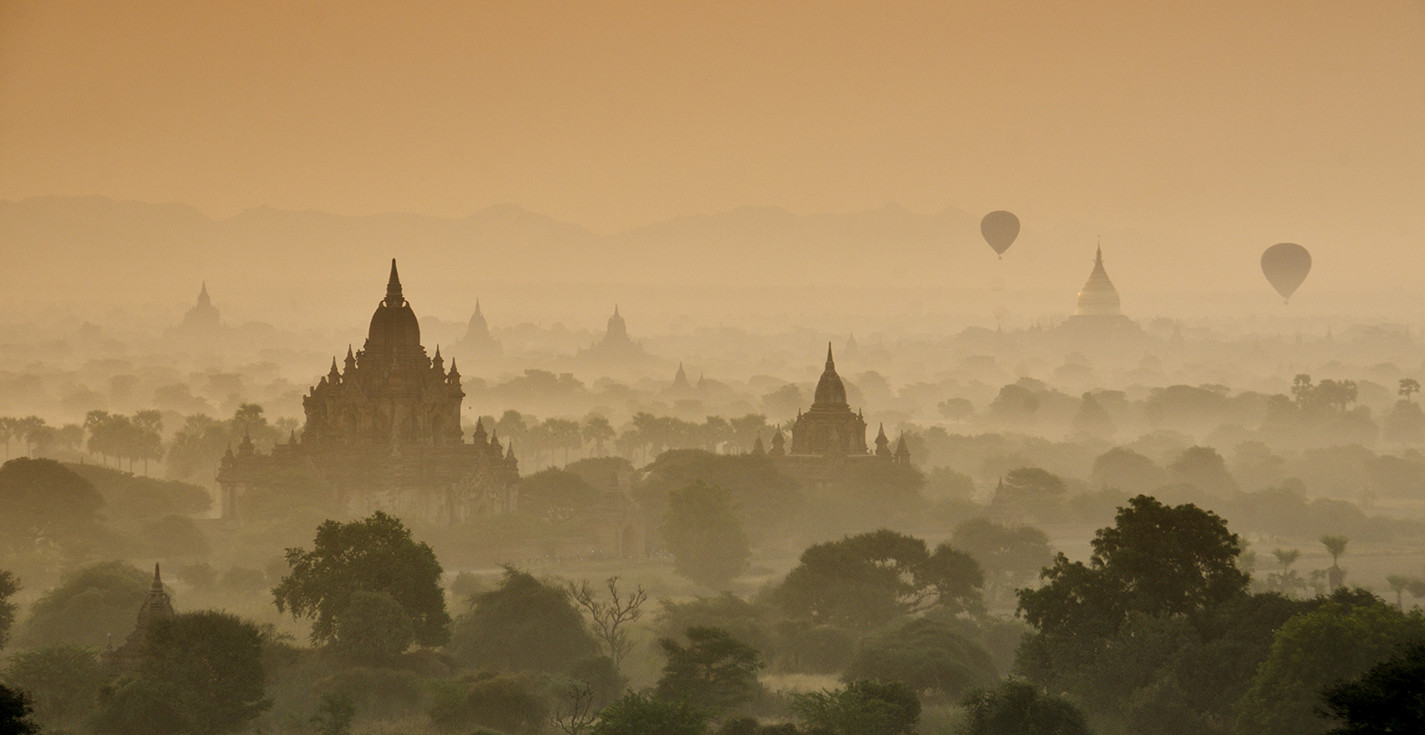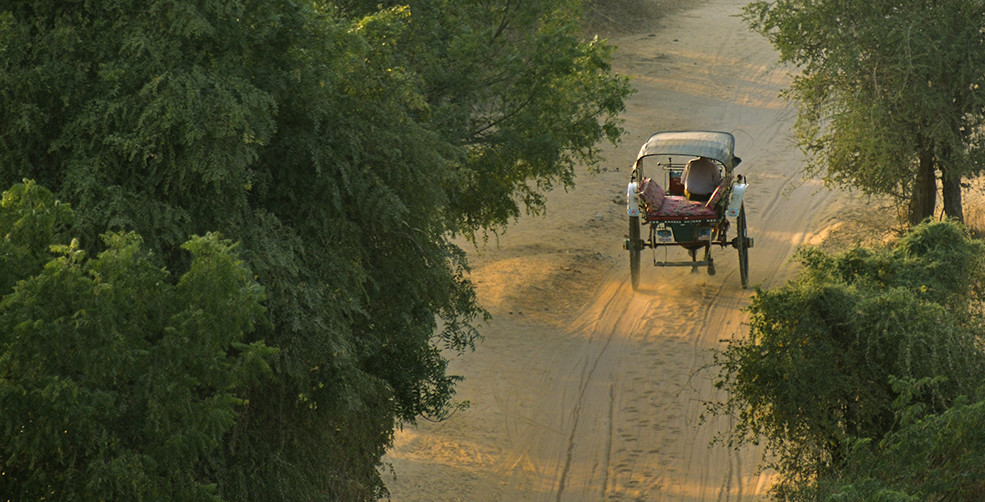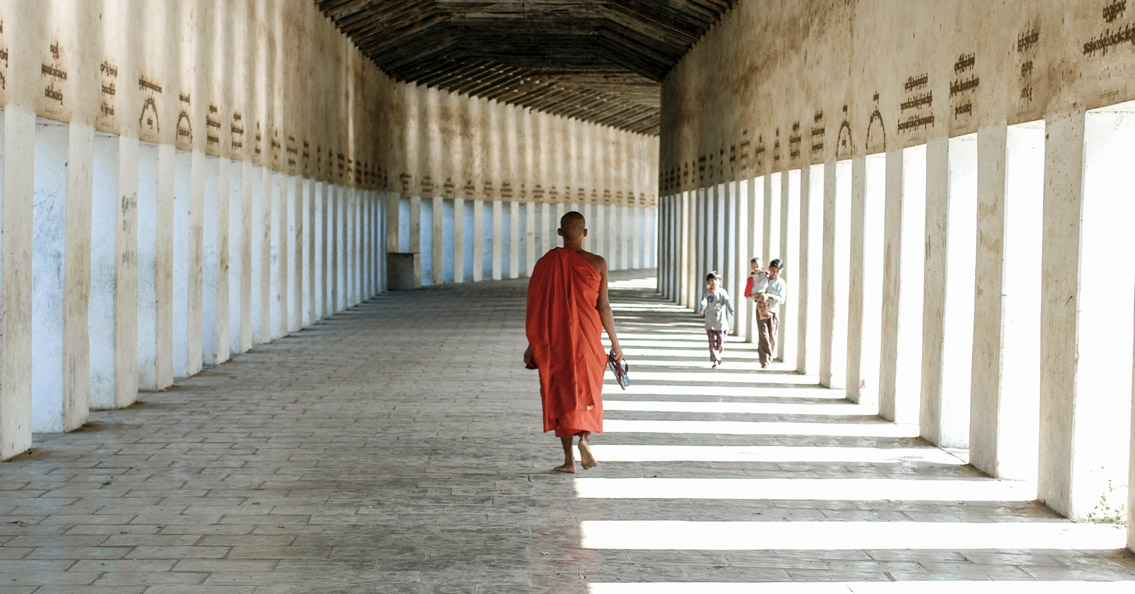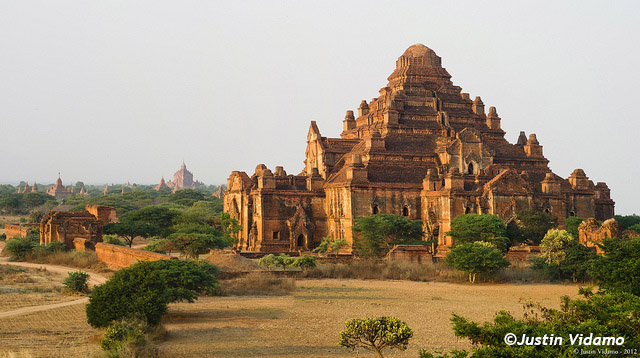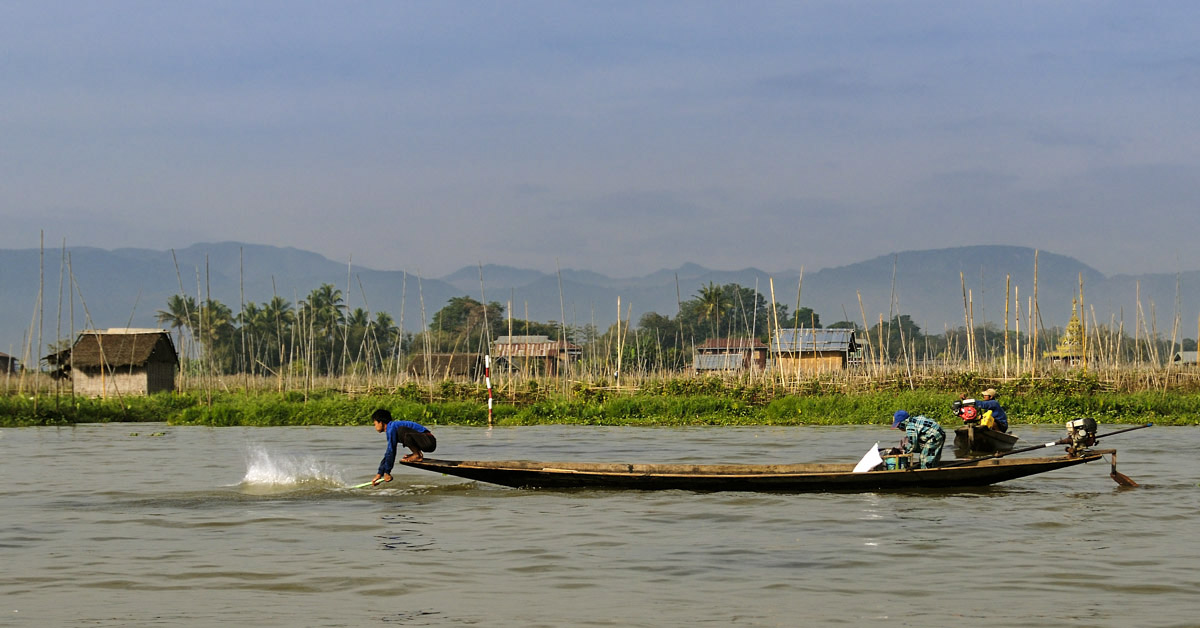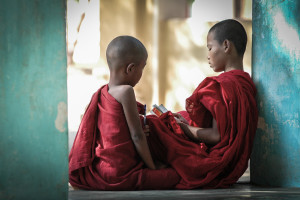Thanks to long tradition and a shaky power supply, handmade industries thrive in Burma. We take a look at – appropriately enough – a handful…
Posted on 9 Jun, 2017
50 million years ago, we would have been deep under the Tethys Sea, swimming with trilobites. Today, however, we can sip coffee (or homemade schnapps, for non-drivers) in the sunshine outside alpine huts, well over a mile above sea level.
Times have changed, here in the Nockberge…
Posted on 25 May, 2017
The Tea Horse Road linked Tibet and South-East Asia for over a thousand years. Heavily-laden mule trains would trek for months from the subtropics to Lhasa, crossing some of the most challenging terrain on earth en route. And for why? All for a cup of tea…
Just outside the village of Shaxi in Yunnan, a bridge arches over the Heihui River. Its flagstones have been worn smooth by generations of travellers’ feet, and it is a beautiful addition to the landscape, but it didn’t really catch my attention until someone told me that the bridge was part of the Tea Horse Road.
It was my first trip to Shaxi, and I had barely heard of the Tea Horse Road, but there’s something about trade routes that inevitably tugs at the imagination. Epic travels over mountain ranges, across deserts and seas, all in order to exchange luxuries like silks or spices – they’re the quintessential overland journeys.
The Tea Horse Road was a network of trails that snaked from the gentle tea-growing hills of southwest China across eastern Tibet to Lhasa and beyond. Many things – beliefs, news, genes – made their way along the route, but the route was established and maintained in order to trade and transport tealeaves.
This tea came from its original home, the humid forests that sprawl across today’s southern Yunnan and northeastern Burma. Here, you can still walk into the woods to see gnarled tea trees that have been tended by Aini, Blang and Jinuo farmers for centuries. The leaves were – and are – steamed and packed into bricks or discs along with the caffeine-and tannin-rich stems and stalks, making the tea easy to transport for the long, tough journey ahead.
The route ran north, out of the subtropics and uphill to Dali, which, at the time of the first tea caravans, was the capital an independent kingdom, Nanzhao. Carried by man and by mule, the tea changed hands with each shift in the terrain. The challenges of adapting to the geographical variation en route would have been insurmountable for a single set of mules and muleteers.
Instead, the tea passed from one people to another as it worked its way north. From Dali, Bai and Hui traders took over, before handing their precious cargo over to Naxi and Yi caravans. Occasionally, the tea would reach the edge of Tibet, where lados (Tibetan muleteers) took over for the longest and most perilous stretch across the mountains of Chamdo to Lhasa.
It was tea that bound the links of this chain together. Along the route, sharing tea was considered as binding as a signature or wax seal, creating trust as it was sipped. Tea also connected the traders to the communities that hosted them, bartering tea balls for access to pasture or supplies.
And yet, while the tea itself was undeniably important to the communities the Tea Horse Road passed through, the mule trains bought something less tasty but even valued with them; Information and news of the world beyond. For many villages along the trail, the muleteers were a vital link to the wider world. When this trading route was bypassed by highways in the mid-twentieth century, these links were largely lost.
The Tea Horse Road existed for trade but it meant more than that. The journey might have been a relay, but it was also a bridge, connecting quite different groups of people to one another, with all working together for a common goal – the humbled and most refined pleasures, a cup of tea.
* * *
For those interested in reading a first-hand account of a modern journey along the Tea Horse Road, we thoroughly recommend occasional On the Road Experiences host, Jeff Fuchs’s 2008 book, “The Ancient Tea Horse Road”.
Our journeys on Tea Horse Roads…
YUNNAN THROUGH A LENS: TEA HORSE TRAILS
Capture memories as beautiful as the landscape on this photographic journey through northwest Yunnan…
Kunming – Xizhou – Lijiang – Tacheng – Shangri-La – Kunming
- • Explore this region’s incredible diversity of plant and animal life, and the large number of ethnic minorites
- • Wander cobbled streets in well-preserved old towns and feel through you and your camera are traveling back in time
- • Photographer Ron Yue will be on-hand to coach you through a series of masterclasses and workshops during this journey
Journey Dossier
Nov 3, 2017
A beautiful back road journey through Yunnan’s less well-known village treasures.
Kunming – Xizhou – Shaxi – Tacheng – Deqin – Shangri-La – Lijiang – Kunming
⦁ Discover a region of northwest Yunnan which can lay a reasonable claim to being the home of James Hilton’s fictional Shangri-La!
⦁ Enjoy the perfect combination of adventure and luxury; often you will find yourself in the middle of nowhere and yet every evening you will be in charming hotels
Journey Dossier
Nov 17, 2017
FROM SHANGRI-LA TO THE LANNA KINGDOM
Cross the borders of three countries within a journey!
Where do we go?
Day 1: Arrive in Kunming
Day 2: Shangri-La to Lijiang
Day 3: In & around Lijiang
Day 4: Lijiang to Xizhou
Day 5: Xizhou to Dianchi Lake
Day 6: Dianchi Lake to Menglun
Day 7: In & around Xishuangbanna
Day 8: Menglun to Luang Namtha
Day 9: Luang Namtha to Chiang Saen
Day 10: In the Golden Triangle
Day 11: Chiang Saen to Chiang Mai
Day 12: Depart from Chiang Mai
What you will discover
Journey Dossier
Dec 22, 2017
Posted on 12 May, 2017
Given that the basic ingredients are so similar (noodles, broth, herbs, meat) you’d be forgiven for confusing South-East Asia’s noodles. To do so publicly, however, would be to invite debate, if not argument. Each country and region is downright passionate about its own take on a humble bowl of noodle soup.
Whichever side of this culinary debate you fall on (and this is something that is well-worth researching), one thing the dishes below have in common is that they are simultaneously exotic and comforting, and – most importantly – utterly delicious…
1. Khao Soi from Chiang Mai
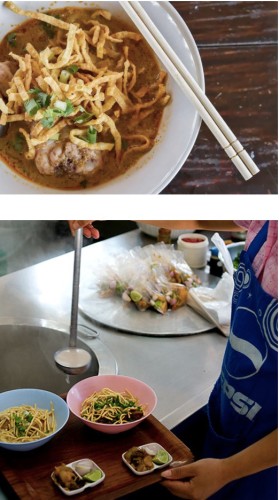 Take a bowl of yellow egg-and-wheat noodles. Add a ladle of thin curry – chicken or beef is traditional, a drizzle of coconut cream, and top with a handful of crunchy deep-fried noodles. Serve with pickles, sliced shallots and wedges of lime, preferably in Chiang Mai. This is the essence of khao soi.
Take a bowl of yellow egg-and-wheat noodles. Add a ladle of thin curry – chicken or beef is traditional, a drizzle of coconut cream, and top with a handful of crunchy deep-fried noodles. Serve with pickles, sliced shallots and wedges of lime, preferably in Chiang Mai. This is the essence of khao soi.
Not to be confused with a totally different Laotian dish of the same name, this is a noodle soup that inspires devotion. Its roots may lie across the border in Burma, but Chiang Mai has adopted khao soi wholeheartedly. The dish is served in simple canteens across the city, with flavours split along broadly religious lines; Halal khao soi joints use a mild curry, while Buddhist-run noodle shops tend to use a much spicier soup.
Once you’ve tasted your first bowl, it’s easy to see why khao soi is one of Chiang Mai’s most famous culinary exports. As chef Andy Ricker puts it, “It’s exotic without being weird and, most important, completely delicious.”
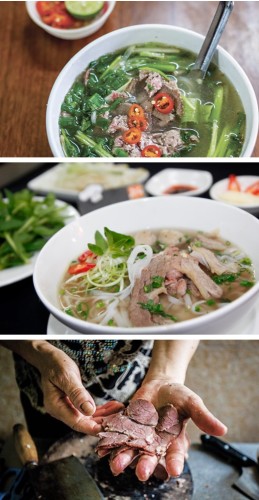 2. Pho Bo from Hanoi
2. Pho Bo from Hanoi
According to an old Vietnamese saying, ask nine people where to get the best pho, and you’ll get 10 different answers. Perhaps the best-known South-East Asian noodle dish after pad thai, Vietnamese pho bo – flat rice noodles served in clear broth and topped with thinly sliced beef brisket and spring onions – are a national obsession. Add a crisp banh quay (deep-fried dough stick) to dunk in the broth, and you have a dish that feels both wholesome and indulgent all at once.
Elsewhere, bowls of pho are served with baskets of fresh herbs, though not in Hanoi, pho bo’s original home. Condiments are sparse too, and limited to garlic vinegar, chillies and – maybe – a wedge of lime. With very little to detract from the flavour of the broth and the cut of the meat, the quality of both is allowed to shine, or not, as the case may be – fortunately, someone’s already done the footwork for you and rounded up the best pho bo spots in Vietnam’s capital.
3. Khao Piak Sen from Luang Prabang
Before dawn each day, noodle shops across Laos fill with the sounds of cooks preparing khao piak. Fresh, thick and round, like Japanese udon but with a little more bounce and bite, these noodles are the core ingredient of khao piak sen.
 Eaten for breakfast and lunch, khao piak sen is Laotian comfort food – chewy noodles, cooked in chicken broth spiked with with lemongrass, galangal and kaffir lime leaves, topped with juicy poached chicken or pork ribs and deep-fried shallots.
Eaten for breakfast and lunch, khao piak sen is Laotian comfort food – chewy noodles, cooked in chicken broth spiked with with lemongrass, galangal and kaffir lime leaves, topped with juicy poached chicken or pork ribs and deep-fried shallots.
This is just the starting point however. A good soup noodle spot will also serve up a mountain of fresh herbs (mint, sweet basil, sawtooth herb, coriander) and raw vegetables (snake beans, watercress, pea shoots, cabbage, lime wedges and birdseye chillies). Tables also groan under the weight of condiments – you’ll see locals working their way methodically through white pepper, sugar, pickled ginger and garlic, soy sauce, white vinegar, fish sauce, sweet chilli sauce, Maggi seasoning and shrimp paste. By the time you’ve finished, your khao piak sen may look nothing like it did when you started, but that’s no bad thing.
4. Mohinga from Mandalay
Bringing together flavours and ingredients from the Subcontinent, China and South-East Asia, mohinga is an apt metaphor for Burma as a whole. Widely considered the country’s national dish, mohinga is served up in teahouses and sold by street vendors across Burma each morning.
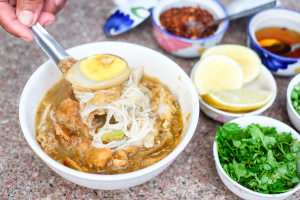 Rice noodles, either thick or thin, are covered in fish broth thickened with chickpea flour, and flavoured with banana blossom, onions, turmeric, lemongrass, garlic and chilli. Toppings add crunch and interest – deep-fried chickpeas, courgette fritters, hard-boiled duck eggs, fresh coriander – making mohinga intensely moreish. Mandalay’s mohinga is less soupy than the Yangon version, leaving more room for those delicious toppings, as well as for a second helping.
Rice noodles, either thick or thin, are covered in fish broth thickened with chickpea flour, and flavoured with banana blossom, onions, turmeric, lemongrass, garlic and chilli. Toppings add crunch and interest – deep-fried chickpeas, courgette fritters, hard-boiled duck eggs, fresh coriander – making mohinga intensely moreish. Mandalay’s mohinga is less soupy than the Yangon version, leaving more room for those delicious toppings, as well as for a second helping.
5. Num Banh Chok from Siem Reap
Cambodia’s quintessential breakfast dish is num banh chok or ‘Khmer noodles’; fresh rice noodles served in a mild fish curry and topped with crisp raw vegetables –cucumber, banana blossom, crunchy water lily stems and fresh mint.
The noodles are made from fermented rice, giving them a slightly tangy flavour, and the curry is flavoured with turmeric – a nod to the long Indian influence that underlies the Khmer language, script and religion. Here in Siem Reap the dish is spiked with more garlic and coconut milk than the original version, and comes with a sweet sauce, tik pha em on the side.
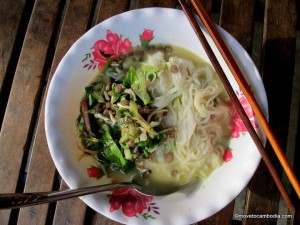 Legend has it that, long ago, a man called Thun Chey was exiled from the Khmer Empire to China. Forced to make a living, he set up a stall selling num banh chok. The dish was so warmly received that Thun Chey was eventually invited to meet the emperor, whom he offended and had him sent back to the Khmers, but not before giving China the inspiration for its own bowls of noodles, which deserve a whole post of their own…
Legend has it that, long ago, a man called Thun Chey was exiled from the Khmer Empire to China. Forced to make a living, he set up a stall selling num banh chok. The dish was so warmly received that Thun Chey was eventually invited to meet the emperor, whom he offended and had him sent back to the Khmers, but not before giving China the inspiration for its own bowls of noodles, which deserve a whole post of their own…
Enjoy Southeast Asia’s Noodles with our cross border journeys…
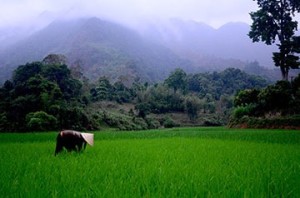 Summit to Sea: From Yunnan to Vietnam will take you on a drive will drive from the edge of Tibet and one UNESCO world heritage town to another right by South China Sea in Vietnam.
Summit to Sea: From Yunnan to Vietnam will take you on a drive will drive from the edge of Tibet and one UNESCO world heritage town to another right by South China Sea in Vietnam.
- 14-day journey
- Kunming – Lijiang – Xizhou – Dianchi Lake – Menglun – Muang La – Dien Bien Phu – Mai Chau – Yen Cat – Dong Hoi – Hue – Hoi An
- Journey Dossier
 Asian Border Lands: Yunnan, Laos, Vietnam is an exploration of the borderlands of China, Laos and Vietnam where minorities live and trade and coexist as if political borders didn’t exist…
Asian Border Lands: Yunnan, Laos, Vietnam is an exploration of the borderlands of China, Laos and Vietnam where minorities live and trade and coexist as if political borders didn’t exist…
- 10-day journey
- Kunming – Menglun – Xishuangbanna – Muang La – Dien Bien Phu – Ban Doi – Mai Chau
- Journey Dossier
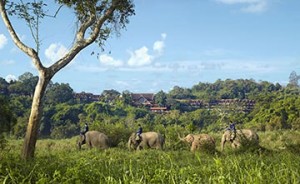 Elephants & Parasols: From Vientiane to the Golden Triangle is a discovery of beautiful landscapes, natural splendor and local culture.
Elephants & Parasols: From Vientiane to the Golden Triangle is a discovery of beautiful landscapes, natural splendor and local culture.
- 9-day journey
- Vientiane – Vang Vieng – Luang Prabang – Muang Xai – Luang Namtha – Chiang Saen – Golden Triangle – Chiang Mai
- Journey Dossier
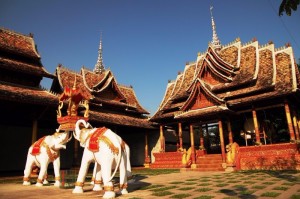 Shangri-La to the Lanna Kingdom will take you from ethnically Tibetan Shangri-La to the tropical heart of the Golden Triangle, then on to Chiang Mai in Thailand – former capital of the ancient Lanna Kingdom.
Shangri-La to the Lanna Kingdom will take you from ethnically Tibetan Shangri-La to the tropical heart of the Golden Triangle, then on to Chiang Mai in Thailand – former capital of the ancient Lanna Kingdom.
- 12-day journey
- Kunming – Lijiang – Xizhou – Xishuangbanna – Luang Namtha – Chiang Sean – Chiang Mai
- Journey Dossier
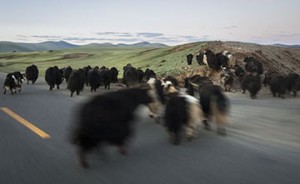 Land of Silk & Snow: Luang Prabang to Lhasa is a discovery of the world’s most stunningly beautiful scenery: From subtropical Laos via Yunnan to the valleys and mountains of the Tibetan Plateau.
Land of Silk & Snow: Luang Prabang to Lhasa is a discovery of the world’s most stunningly beautiful scenery: From subtropical Laos via Yunnan to the valleys and mountains of the Tibetan Plateau.
- 16-day journey
- Luang Prabang – Luang Namtha – Menglun – Lake Dianchi – Xizhou – Lijiang – Shangri-La – Deqin – Markham – Zogang – Rawok – Pomi – Bayi – Lhasa
- Journey Dossier
Posted on 4 May, 2017
Faces from the Land of Snows
Many of us are nervous when it comes to taking a stranger’s photograph, but portraits often provide the best memories – and the most striking images – from a trip. Professional photographer and our photography coach, Ron Yue presents some of his favourite portraits from Tibet…
|
When travelling on the Tibetan Plateau, one of the most striking things is how devout most people are. Their Buddhist faith decides and drives many aspects of everyday life. The lady with the beautiful coral earrings (below) was pausing mid-kora (prayer circuit) on the Barkhor in Lhasa. To the uninitiated, the Barkhor’s foot traffic seems unceasing, but to Tibetans it is punctuated with holy places and tiny shrines, spaces to stop, reflect and pray.
The Barkhor is Lhasa’s religious heart, but the city is also ringed by great monasteries, each with its own tradition of learning. Here, at Sera, young monks gather each afternoon to debate scripture. Each point is illustrated with a dramatic flourish – the clapping of hands, the stamping of feet and the striking down of their opponent’s point.
These scenes are repeated – with local variations – acoss the Tibetan Plateau, from Yunnan to Ladakh. Below, a lady prays with a mala (a string of 108 prayer beads) wrapped around her fingers, in the dawn light outside the Ganden Sumtseling Monastery, a thousand kilometres east of Lhasa.
It is not just the elderly that follow Buddhist traditions. In fact, many pilgrimages are so strenuous that only the young can attempt them. Below, a teenagerl prostrates herself on the Barkhor kora. After I shot this photograph she stood up, moved two paces forward and lay down again, measuring the length of the circuit with her body. She will complete the kora 108 times like this before her pilgrimage is complete.
Not all religious practices are so arduous though – for the onlookers at least! Below, a man picked from the crowd at Gyantse’s Saga Dawa celebrations is covered with flour by a clown. These clowns are tasked with keeping the audience amused, against a backdrop of solemn religious dances.
Far from Tibet’s towns and monasteries, a nomadic lady (below) welcomed us into her black yak-hair tent. Once common, nomads’ camps are becoming harder to find, as the government encourages the drokpa to move into permanent housing.
As a photographer, these final two images are among my favourites. A young boy in Shigatse shows me how it’s done…
…and a lady decked out in beautiful turquoise and coral jewelry takes a quick snap in Yunnan:
Each time I travel in Tibet I find new inspiration from its incredible landscape and wide open skies, but it’s the memories of connecting with people here that I always remember most fondly. What a special part of the world! |
Our journeys in the Land of Snows…  From Lhasa to Mt. Everest Base Camp… Where do we go? Day 1: Arrive in Kunming What you will discover ⦁ Lhasa, the capital of Tibet with the Potala Palace and the holiest Tibetan temple, the ⦁ Visit the old towns of Gyantse and Shigatse ⦁ Drive along Lake Yamdrok and Lake Namtso, the two holiest lakes in Tibet ⦁ Enjoy an unforgettable view Journey Dossier
————————————  Our ALL NEW, UNIQUE journey from subtropical Lao to the Himalayas…
Where do we go? Day 1: Arrive in Laos What you will discover ⦁ Drive from charming Luang ⦁ Highlights include: Luang Prabang, Xishuangbanna, Meili Snow Mountain, Ranwu Lake, Lhasa and much more in between Journey Dossier ————————————
 Our most magnificent photography trip in Tibet
Where do we go? Day 1: Arrive in Kunming What you will discover ⦁ Lhasa, Mt. Everest, holy lakes, adventure, blue skies, snow-capped mountains, red-robed monks, the Jokhang, the Potala, open roads…a journey for *your* life time! ⦁ Learn how to see beauty and capture moments with Master Photographer Ron Yue and Journey Dossier Stories |
Posted on 3 May, 2017
Wherever your itinerary takes you, travel in Burma is sure to provide a wealth of new experiences – whether you’re air-kissing at your waiter in a city teahouse or witnessing your first nat ceremony.
This is our guide to ten of the country’s best experiences…
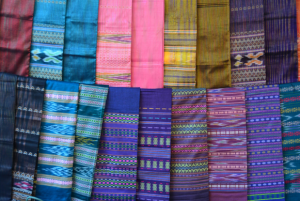 9. Try on a longyi
9. Try on a longyi
Once you’ve sorted out your thanaka, the natural next step is to get yourself a longyi – a tube of fabric worn by men and women across Burma. The male version (known as a paso) is often nattily checked or striped, and tied with a knot in front, while the female version (a htamein, as shown in the photo) is more richly patterned, and tucked into a fold around the waist. Pick out your favourite design and take it to a tailor, who will sew it up for you (though one size essentially fits all) and you’re all set – just ensure that it’s tied tightly enough to avoid any inadvertent flashing…
10. Take it easy
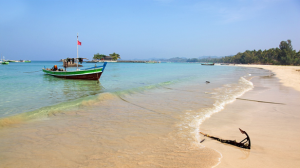 Wherever your itinerary takes you, something about a trip to Burma invites you to tackle life more slowly, whether you’re following a bullock cart down a country road or spending an afternoon lazily looking out over the Andaman Sea from a hammock. Slow travel at its most natural, and best!
Wherever your itinerary takes you, something about a trip to Burma invites you to tackle life more slowly, whether you’re following a bullock cart down a country road or spending an afternoon lazily looking out over the Andaman Sea from a hammock. Slow travel at its most natural, and best!
Experience the best of Burma with us…
A BURMESE JOURNEY: From the Lanna Kingdom to the Bay of Bengal
This journey is a discovery of Burma’s beautiful scenery and traditions.
This spectacular itinerary will take you from Chiang Mai, Thailand, former capital of the ancient Lanna Kingdom through Burma – the “Golden Land” – to the Bay of Bengal
- 12 or 17 Day-journey (Please note that while the full journey is 17 days, we also offer a shorter version. Please contact us for details.)
- Chiang Mai – Mae Sot – Hpa An – Taungoo – Inle Lake – Pindaya – Mandalay – Bagan – Magwe – Pyay – Ngapali
- Journey Dossier
- Travel Dates: Nov 3 – Nov 19, 2017 /Nov 24 – Dec 10, 2017/Jan 9 – Jan 25, 2018/Feb 8 – Feb 24, 2018
Posted on 22 Apr, 2017
When is a photo more than a photograph?
The interview wasn’t going to plan. I was talking to two young people, Hugo (11) and Astrid (8), who joined our first family photography trip a year ago. The thing was, they couldn’t remember very much about it. I had arrived with a neat set of questions: Were you interested photography before the trip? What was the most memorable part? Astrid remembered a friendly dog; Hugo a young boy playing with blocks.
We began to look through photography coach, Ron Yue’s photographs from the trip. These jogged their memories, and more details began to emerge – though seldom the ones I expected.
|
The itinerary starts in Kunming before heading to north-west Yunnan, taking in Dali, Shaxi, Lijiang, Tacheng before it ends in Shangri-La. I know the route very well, having driven it maybe twenty times, and love it for the vernacular architecture, minority cultures and beautiful scenery en route. But Hugo and Astrid had experienced the trip quite differently.
As we turned to look at the photos the children had taken themselves, funnier and more personal stories surfaced; one about Astrid riding a goat, another about someone photo-shopping pimples all over a photograph of his friend’s face, before Hugo turned the boy’s picture purple.
They each picked out specific photographs – Hugo had taken a clutch of photos in Lijiang on a setting that turned the evening sky electric blue, leaving the streetlamps shining a warm orange light onto the crowds below, Astrid had spent time trying to capture a beautiful lock from an interesting angle. We oohed and aahed over some more great shots of the monkeys, and found a picture of Astrid’s friendly dog.
Our conversation made me realise how much I expected them to trot out the same things that I find noteworthy about the itinerary. It was refreshing and interesting to see familiar places in a new way, and a valuable reminder that we all see and experience the world differently. And that comes through in all our photographs, whether we’re young or old, novice or seasoned professional.
On every photo trip I’ve hosted, the final night wrap-up session, where everyone shows their best photos from the trip, has led guests to ask one another “Where did you take that?” – because it shows an aspect of something they didn’t notice themselves. But, equally, another thing that I appreciate again after talking to Astrid and Hugo is just how effective photographs are at capturing a moment, a mood and a feeling. Of course, looking at their shots reminded them of what was shown in the photograph itself, but it also helped them to recall other stories and moments from the trip. When I spoke to Ron about this, he agreed; “I think I can remember the circumstances behind almost every photo I’ve taken – the back story, a general feeling,” and this from a man who takes pictures for a living.
So there it is; each of us puts more of ourselves into our photographs than we might realise, just as we get more out than we might expect. My thanks to Astrid and Hugo for reminding me of this – as well as for proving that it is, indeed, possible to ride a goat. |
Our journeys for family and kids… Where do we go? Day 1: Arrive in Kunming What you will discover ⦁ Experiences, not things ⦁ Give your children the gift of ⦁ Come home with wonderful
Journey Dossier
————————————  Go on a Family Holiday you will never forget! Go on a Family Holiday you will never forget!Where do we go? Day 1: Arrive in Kunming What you will discover ⦁ Introduce you and your ⦁ Come up-close-and-personal ⦁ Practice your Mandarin… Journey Dossier
Stories |
Posted on 14 Apr, 2017
Yunnan’s food is one of China’s most delicious surprises, yet Yunnanese cuisine is not well known outside China. Why is this the case? We look at six foods that define this fascinating and beautiful province.
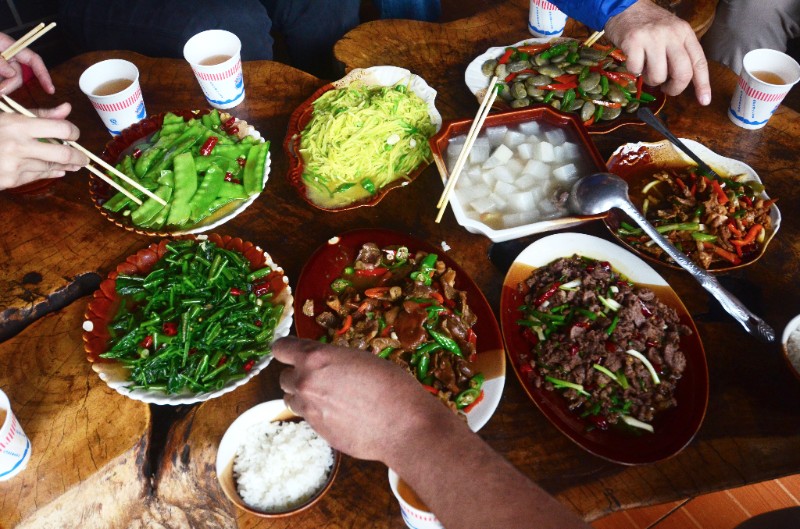
 Too often, Yunnanese cooking overseas is reduced to a single dish – “crossing bridge noodles” (see below for the story behind this dish’s name). Individual bowls of piping hot broth are served along with plates of raw meat, vegetables and noodles that diners tip into the soup to cook. While people from Yunnan certainly do love a bowl of rice noodles, there’s much, much more to food here.
Too often, Yunnanese cooking overseas is reduced to a single dish – “crossing bridge noodles” (see below for the story behind this dish’s name). Individual bowls of piping hot broth are served along with plates of raw meat, vegetables and noodles that diners tip into the soup to cook. While people from Yunnan certainly do love a bowl of rice noodles, there’s much, much more to food here.
Thanks to Yunnan’s varied topography and climate, the province’s markets are filled with a huge range of fresh, seasonal produce. Exotic fruit thrives in the warmth of tropical Xishuangbanna; huge ears of corn ripen in the fertile land around Dali; Dongchuan’s rust red soil produces wonderful potatoes; sweet, crisp apples grow around Lijiang, and fungi with fantastic names (termite mushrooms, anyone?) are dried and exported from Yunnan across Asia.
Each of Yunnan’s ethnic groups puts its own twist on the preparation of these local ingredients. Around Shangri-La, Tibetan cooks flavor dishes with dried peppers and cumin; the Drung of the Salween Valley traditionally cook on heated stones; Xishuangbanna’s Dai people enjoy a combination of intense chili heat and pickled sourness that can make a good Dai meal feel like an assault on the tastebuds.
All this variety makes Yunnanese food tricky to define. Indeed, one reason why Yunnanese food is little-known outside its home territory is that there’s little agreement over what exactly Yunnanese cuisine is – besides crossing bridge noodles, that is. Another reason is that many of the more unusual ingredients are downright impossible to find outside of south-west China – from fishwort roots (折耳根) to bee pupae. However, such exotic things don’t really tell the story of the province. These, more humble, everyday foods do:
1. Rice
 Rice in one of its forms – steamed rice, sticky rice or rice noodles – is the core of most Yunnanese meals. Tiers of rice paddies that have been carefully maintained by generations of farmers are a testament to the crop’s importance, especially in the south-east of Yunnan, home of Yuanyang’s spectacular “ladder fields”.
Rice in one of its forms – steamed rice, sticky rice or rice noodles – is the core of most Yunnanese meals. Tiers of rice paddies that have been carefully maintained by generations of farmers are a testament to the crop’s importance, especially in the south-east of Yunnan, home of Yuanyang’s spectacular “ladder fields”.
Rice noodles have evolved into many different varieties in Yunnan (flat ones, round ones, thick ones, skinny ones, soft ones, chewy ones), and are especially popular at breakfast time, when they are served in soup and topped with ground meat, fresh herbs and lashings of chili. It’s worth seeking out a Yunnanese special – ersi made from cooked rice, which gives the noodles an unusual (and delightful) chewy texture.
It’s also worth making a fairly long detour to try Dai pineapple rice in Xishuangbanna. Soaked sticky rice is mixed with the flesh of a ripe pineapple and steamed inside the pineapple shell, producing a nectar-sweet antidote to the chili-fueled heat of the typical Dai meal. Which brings us to…
2. Chili peppers
Sandwiched, as it is, between Sichuan and South-East Asia, it is unsurprising that Yunnan shares its neighbours’ love affair with the chili pepper. On an early On the Road trip, the lead car was scene of a heated and protracted debate between our Yunnanese guide and Sichuanese driver as to which province’s food was the hotter.
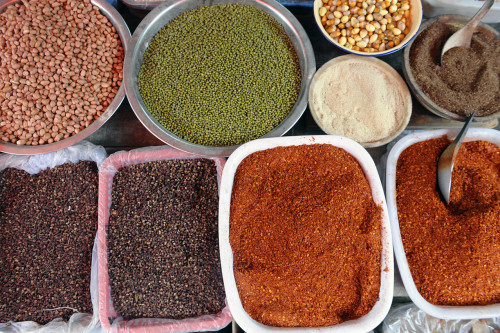 The jury may still be out on that important question, but dried and fresh chilies as well as mouth-numbing Sichuan pepper are all used frequently in Yunnanese kitchens. Happily for the faint of palate, their addition is often optional – a saucer of chopped chili or chili sauce placed on the table.
The jury may still be out on that important question, but dried and fresh chilies as well as mouth-numbing Sichuan pepper are all used frequently in Yunnanese kitchens. Happily for the faint of palate, their addition is often optional – a saucer of chopped chili or chili sauce placed on the table.
3. Mushrooms
A remarkable 800 varieties of edible mushroom (from a total of 3,000 known types worldwide) can be found in Yunnan, the region being a biodiversity hotspot for fungi, as well as plants and animals. Some are familiar – porcini, chanterelles, summer truffles – while others are decidedly less common – tripe-like zhusun and poisonous-looking green cap mushrooms, for example.
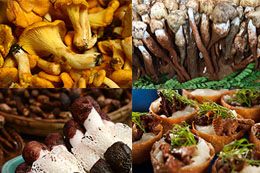 King of them all, however, is the songrong or matsutake, prized in Japan (where it commands prices of up to US$1000 per pound) for its fragrance and meaty texture. In local homes, fresh mushrooms will be simply stir-fried with a little bacon and slices of fresh green chili, but in Kunming’s restaurants the preparation is altogether more sophisticated, with songrong topping a slab of foie gras or a delicate steamed custard.
King of them all, however, is the songrong or matsutake, prized in Japan (where it commands prices of up to US$1000 per pound) for its fragrance and meaty texture. In local homes, fresh mushrooms will be simply stir-fried with a little bacon and slices of fresh green chili, but in Kunming’s restaurants the preparation is altogether more sophisticated, with songrong topping a slab of foie gras or a delicate steamed custard.
4. Cheese
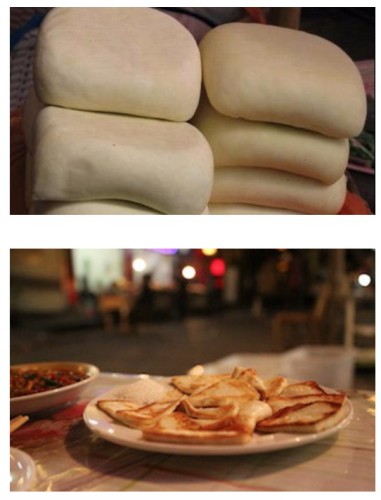 Unusually for China, two ethnic groups in Yunnan have been producing and consuming cheese for centuries. Separated by 500km of non-cheese eating minorities, the Bai and Sani may have developed their cheese-making techniques and traditions in isolation.
Unusually for China, two ethnic groups in Yunnan have been producing and consuming cheese for centuries. Separated by 500km of non-cheese eating minorities, the Bai and Sani may have developed their cheese-making techniques and traditions in isolation.
However, one tantalizing theory has the Mongolian armies of Kublai Khan introducing cheese-making in the wake of their invasion of the Dali Kingdom in the mid-thirteenth century. (Amazingly, there are still ethnic Mongolian communities in Yunnan today – the descendants of the Khan’s garrisons.)
The Bai of Dali make slabs of white paneer-like rubing from cow’s milk, while the Sani people from Shilin, southeast of Kunming make a similar cheese from sheep’s milk. Rubing is delicious when fried (it doesn’t melt) and sprinkled with salt or sugar. The Bai also make rushan, wafer-thin sheets of cheese that you will see stacked in rolls outside Bai restaurants around Dali.
5. Wind-cured ham
In village houses across northern Yunnan, you’ll often see legs of ham – trotters still attached – lurking in the rafters. As with all the best local foods, there is much competition between counties that claim to produce the most delicious version; Xuanwei’s ham may be the best-known, but the black pigs raised on the banks of the Salween and those from around Lake Erhai are now acknowledged to produce some of the best.
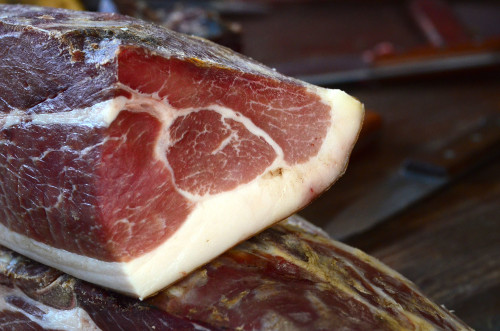 Historically, Yunnan has never been a wealthy province; for many people here, meat had to be used sparingly. Salting and drying pork to preserve it and intensify its flavour was one of the best ways to do this. Typically, slices of ham might be tossed into fried vegetables, served with rubing in a kind of Yunnanese ham and cheese, or in one unusual dish, sizzled on a hot roof tile (瓦掌风肉).
Historically, Yunnan has never been a wealthy province; for many people here, meat had to be used sparingly. Salting and drying pork to preserve it and intensify its flavour was one of the best ways to do this. Typically, slices of ham might be tossed into fried vegetables, served with rubing in a kind of Yunnanese ham and cheese, or in one unusual dish, sizzled on a hot roof tile (瓦掌风肉).
6. Pu’er tea
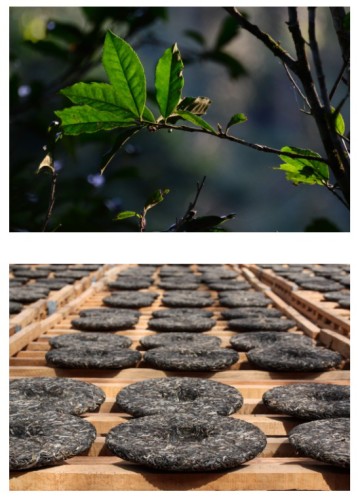 For those of us used to seeing tea bushes in neat ranks, pruned to hip height, the sight of a wizened tea tree deep in tropical jungle seems almost odd. And yet the leaves of these aged trees produce some of the finest tea in the world.
For those of us used to seeing tea bushes in neat ranks, pruned to hip height, the sight of a wizened tea tree deep in tropical jungle seems almost odd. And yet the leaves of these aged trees produce some of the finest tea in the world.
Bricks of tea from southern Yunnan have been exported around Asia for hundreds of years. Leaves of the wild tea trees are dried, fried and steamed into dimpled circles. Once upon a time, these would then be stacked onto mules for the long trek to Tibet. The tea would slowly age on its journey, bringing a depth of flavor that is now much prized – though many accounts of this “tea horse trail” have the Tibetans showing more interest in the tea’s ability to alleviate the effects of a meat-heavy diet, rather than the health-giving qualities we recognize today. Many small towns in north-west Yunnan – Shaxi and Jianchuan, to name two – grew up around overnight stops used by the tea caravans, spreading Pu’er tea’s impact across the province and down the centuries.
*Legend has it that a Qing-dynasty scholar retired to Mengzi in south-east Yunnan where he spent each day in a lakeside pavilion, writing poetry. His wife brought him noodles for lunch each day. The noodle soup cooled on the walk between kitchen and pavilion until she hit upon the idea of topping the broth with a layer of oil, thus sealing in the heat for her journey.
Explore Yunnan’s foods with our journeys…
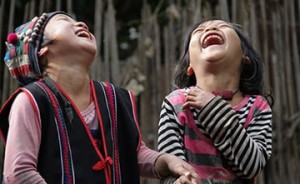 Adventures in Yunnan will take you and your family through some of Yunnan’s best loved destinations like Dali, Lijiang and Shangri-La and via some little-known gems on an itinerary designed specifically for families to enjoy together.
Adventures in Yunnan will take you and your family through some of Yunnan’s best loved destinations like Dali, Lijiang and Shangri-La and via some little-known gems on an itinerary designed specifically for families to enjoy together.
- 10-day journey
- Kunming – Dali/Xizhou – Shaxi – Tacheng – Shangri-La – Lijiang
- Journey Dossier
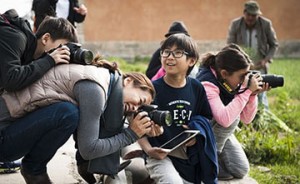 Family Adventures: Travel Photography in Yunnan is a family holiday you will never forget, a chance to discover new lands and people and to engage with a hobby – photography! – that may become a lifelong, shared passion among parents and children.
Family Adventures: Travel Photography in Yunnan is a family holiday you will never forget, a chance to discover new lands and people and to engage with a hobby – photography! – that may become a lifelong, shared passion among parents and children.
- 10-day journey
- Kunming – Dali/Xizhou – Lijiang – Tacheng – Shangri-La
- Journey Dossier
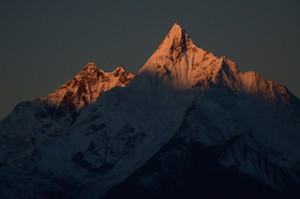 Searching for Shangri-La takes you on back roads through Yunnan’s less well-known village treasures to the edge of Tibet
Searching for Shangri-La takes you on back roads through Yunnan’s less well-known village treasures to the edge of Tibet
- 9-day journey
- Kunming – Dali/Xizhou – Shaxi – Tacheng – Deqin – Shangri-La – Lijiang
- Journey Dossier
 Shangri-La to the Lanna Kingdom will take you from ethnically Tibetan Shangri-La to the tropical heart of the Golden Triangle, then on to Chiang Mai in Thailand – former capital of the ancient Lanna Kingdom.
Shangri-La to the Lanna Kingdom will take you from ethnically Tibetan Shangri-La to the tropical heart of the Golden Triangle, then on to Chiang Mai in Thailand – former capital of the ancient Lanna Kingdom.
- 12-day journey
- Kunming – Lijiang – Xizhou – Xishuangbanna – Luang Namtha – Chiang Sean – Chiang Mai
- Journey Dossier
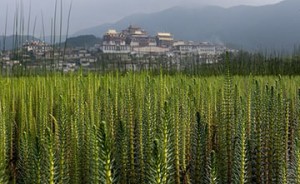 Yunnan through a Lens: Tea Horse Trails – capture memories as beautiful as the landscape on this photographic journey through breath-taking north-west Yunnan.
Yunnan through a Lens: Tea Horse Trails – capture memories as beautiful as the landscape on this photographic journey through breath-taking north-west Yunnan.
- 9-day journey
- Kunming – Xizhou – Lijiang – Tacheng – Shangri-La
- Journey Dossier
Posted on 13 Apr, 2017
The Yarlung Tsangpo is Tibet’s most important river. We take a whirlwind trip down its course…
A raindrop (or, more likely, a snowflake) falling near Mount Kailash in could have one of three fates. If it lands to the north or west of Tibet’s holiest mountain, it will trickle into the Indus, flow across Ladakh, down the length of Pakistan and into the Arabian Sea. Fall to the south of the mountain and it will promptly cascade out of Tibet into Nepal, and – joining the Ganges – run across northern India, draining through Bangladesh into the Bay of Bengal. Finally, if it lands east of Kailash, our raindrop will join the Yarlung Tsangpo.
|
Tibet’s most important river, the Yarlung Tsangpo flows east across Tibet for two thousand kilometres before it finds a way through the Himalayas and pours into India, where it is known as the Brahmaputra, “Son of Brahma”. A journey along the Yarlung Tsangpo is a journey through Tibet’s most dramatic landscapes as well as through Tibetan history. The young river meanders out of Tibet’s far west through sand dunes in a beautiful and rugged land. Although few live here now, this was once part of the Zhang Zhung kingdom, a pre-Buddhist civilisation that has left a handful of enigmatic ruins and soot-blackened caves near Mount Kailash.
In flowing through more populated regions, our river performs a new purpose. The rocky riverbanks are marked with white ladder-like symbols, showing that a water burial has been held recently. Although Tibetan sky burials are well-known, poorer people more often wrap their dead in cloth and slide the bodies into the river – one important reason why Tibetans do not eat fish.
|
Explore Tibet with our journeys… Lands of Silk & Snow: From Luang Prabang to Lhasa ALL NEW, UNIQUE journey from subtropical Laos to the Himalayas Where do we go? Day 1: Arrive in Laos We also offer shorter version of this journey – 10 & 13 Days What you will discover ⦁ Drive from the charming
Luang Prabang to Lhasa in
Tibet… ⦁ Highlights include: Luang
Prabang, Xishuangbanna, Meili Snow Mountain, Ranwu Lake (然烏湖), Lhasa and much more in between
Journey Dossier – – – – – – – – – – – – – – – – – – – Roads on the Roof of the World From Lhasa to Mt. Everest Base Camp Where do we go? Day 1: Arrive in Kunming What you will discover ⦁ Lhasa, the capital of Tibet
with the Potala Place and the
holiest Tibetan temple, the Jokhang temple ⦁ Visit the old towns of Gyante and Shigatse
⦁ Drive along lake Yamdrok and Lake Namtso, the two holiest in Tibet
⦁ Enjoy an unforgettable view
over the Himalayas and drive
right to the Mt. Everest Basecamp Journey Dossier Stories on Tibet A Glimpse of Everest |
*Botanist Frank Kingdon Ward had this to say about a trip here in the 1920s:
Not only is Pemako extraordinarily difficult to reach from any direction, it is still more difficult to penetrate and explore when reached. Surrounded on three sides by the gorges of the Tsangpo, the fourth is blocked by mighty ranges of snow mountains, whose passes are only open for a few months in the year. Beyond these immediate barriers to east, west and south are trackless forests inhabited by wild unfriendly tribes… Add to this… a climate which varies from the subtropical to the arctic, the only thing common to the whole region being perpetual rain, snakes and wild animals, giant stinging nettles and myriads of biting and blood sucking ticks, hornets, flies and leeches…
The Riddle of the Tsangpo Gorges, Kingdon Ward, 1926

Posted on 30 Mar, 2017
Bagan is one of Burma’s most popular destinations.
Is it worth the hype?
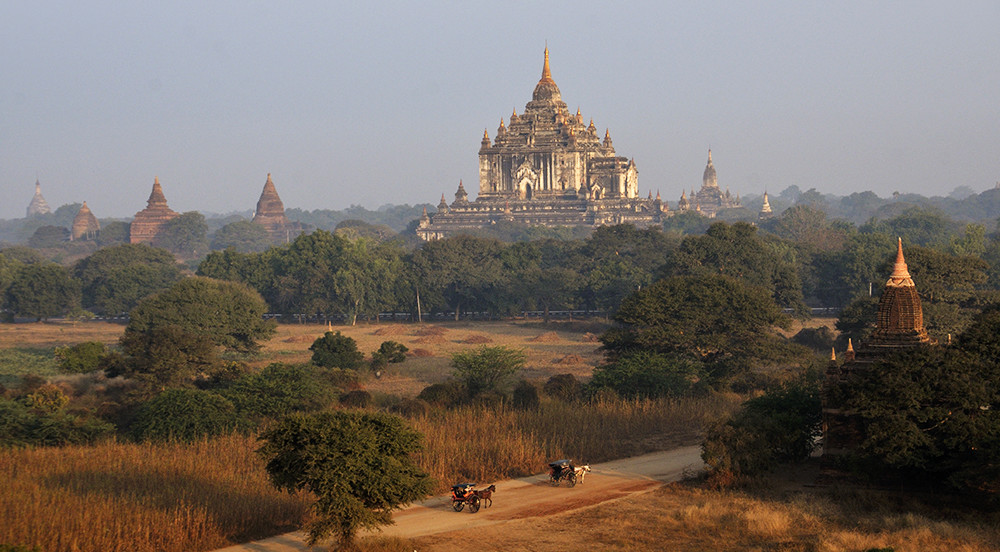
Somewhere in the middle of Burma, the once-thriving kingdom of Bagan lies in ruins. Thousands of pagodas – some well-preserved, others little more than heaps of ornate bricks – cover the left bank of the Irrawaddy on the inside of a giant southward bend.
The heaps of bricks grew a little more numerous in August 2016, when a 6.8-magnitude earthquake hit Central Myanmar. 185 of Bagan’s monuments sustained major damage. However, says one architect who surveyed the site in the earthquake’s aftermath, “…the damage could have been much worse”. In many cases, the worst damaged temples were those that had been most heavily (and shoddily) reconstructed in the late 1990s, and several important pagodas – Sulamani, North Guni and That Bin Nyu – remain closed.
For all that, however, at sunrise and sunset, in the warm light of the “golden hour”, crowds are still drawn to temple terraces to see the awe-inspiring landscape below, as hot-air balloons drift lazily over the temple-littered Bagan Plain – a sight that draws many to visit Burma in the first place.
Despite being one of Burma’s top destinations, Bagan’s size (roughly 100km2) diffuses the impact of visitor numbers. It’s possible to explore – by horse and cart, bicycle or car – and to see few other visitors, save for at the most popular pagodas and attractions. The region’s small towns and villages remain sleepy, even by Burmese standards.
Peaceful though Bagan may be today, its history has featured plenty of drama. Bamar raiders from Yunnan founded a settlement here in the middle of the 9th century. By 1044, when the energetic King Anawrahta acceded the throne, Bagan had grown into a statelet that stretched as far as Mandalay and Magway. Anawrahta transformed his kingdom, uniting most of the territories that comprise modern Burma for the first time, establishing Buddhism as the Bagan’s foremost religion, and building the first pagodas.
Pagodas, or paya as they’re known in Burmese, are built to accrue merit, erasing sins and earning their sponsor an easier rebirth. Given the appalling behaviour of some of Bagan’s monarchs, the reason for the sheer numbers of paya here becomes clearer; a twelfth-century king, Narathu, constructed the vast Dhammayangyi Paya (pictured below) in the hope that it would improve his karma after murdering his father, brother and wife. (It seems doubtful that this worked, at least in that particular incarnation – he survived just two years on the throne before being assassinated by his angry father-in-law.)
Eventually, in the late thirteenth century the Kublai Khan’s Mongol armies launched a series of attacks against the kingdom. Although they never reached Bagan itself, the last king, Narathihapate, fled south anyway, earning himself the soubriquet Tayok-pyay-min, “The King who ran away from the Chinese”, his empire ceasing to exist almost overnight.
Bagan’s heyday may have ended when the Mongols left Burma in 1303, but in contrast its builders’ and artisans’ legacy has endured for seven centuries, surviving earthquakes and monsoon floods. The sheer scale of the site, the significance of its history, and the beauty of its architecture and art rightfully give Bagan a place on most “must-see” lists, whether you’re a specialist in Asian art, or simply want a really unforgettable balloon ride.
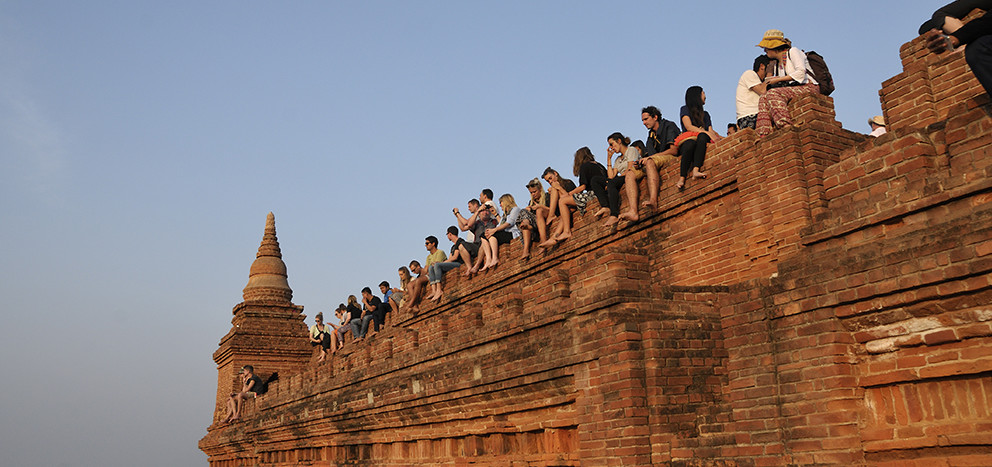
With so many monuments, it can be hard to know where to start when it comes to exploring Bagan. Our advice is to take your time – rush and you’re likely to become rapidly templed-out. Old Bagan, with the site’s densest and most diverse collection of temples, makes a logical starting point, but thereafter you might prefer to wander at will, perhaps with one of the major temples elsewhere as an end destination. Many of the less-visited temples are locked (although caretakers often magically appear to unlock the doors when needed, for a small tip – around K500), and it’s a good idea to take a torch to appreciate the murals that decorate many pagodas.
As far as sunset and sunrise go, the Myanmar government is currently building four viewing points that will reduce the wear-and-tear on Bagan’s ancient buildings. Once the last of these is completed, the viewing sites at older temples will be closed. For now, however, you can still sit atop ancient, sun-warmed walls and watch the dying rays of the sun over beautiful Bagan. Some temples may be closed or swathed in scaffolding, and it may be one of the country’s major destinations, but yes, it is very much still worth visiting.
But beyond Bagan and its temples lies the rest of Burma. The country is changing quickly, but there is little sense of this outside of Yangon and Mandalay. In the countryside, life continues unhurriedly; women still wash clothes and wriggling children in the Irrawaddy, men still drive bullock carts down dusty country roads and sip palm wine in the shade. For many visitors – myself included – it is Burmese people and countryside life that provide the most vivid memories from a journey here. When you are planning your own Burmese journey, make sure that you, too, go beyond Bagan.
Experience the best of Burma with us…
Explore Burma with your camera and professional photographer, Ron Yue.
We take you to Bagan and beyond on this special photography journey, designed to showcase Burma’s most photogenic places.
-
10 Day-journey
- Yangon – Nay Pyi Taw – Inle Lake – Pindaya – Mandalay – Bagan
- Travel Dates: Nov 21 – 30, 2017
A BURMESE JOURNEY: From the Lanna Kingdom to the Bay of Bengal
This journey is a discovery of Burma’s beautiful scenery and traditions.
This spectacular itinerary will take you from Chiang Mai, Thailand, former capital of the ancient Lanna Kingdom through Burma – the “Golden Land” – to the Bay of Bengal
-
12 or 17 Day-journey (Please note that while the full journey is 17 days, we also offer a shorter version. Please contact us for details.)
- Chiang Mai – Mae Sot – Hpa An – Taungoo – Inle Lake – Pindaya – Mandalay – Bagan – Magwe – Pyay – Ngapali
-
Travel Dates: Nov 3 – Nov 19, 2017 /Nov 24 – Dec 10, 2017/Jan 9 – Jan 25, 2018/Feb 8 – Feb 24, 2018
